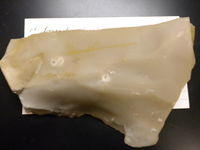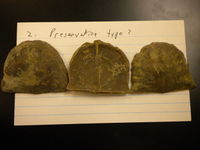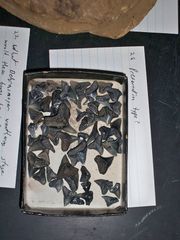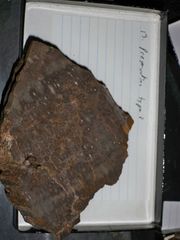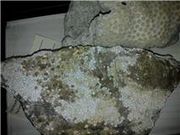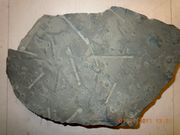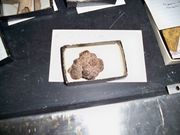Talk:Taphonomy
- [View source↑]
- [History↑]
Contents
| Thread title | Replies | Last modified |
|---|---|---|
| Recrystallization | 1 | 14:29, 3 March 2011 |
| Replacement | 2 | 14:10, 3 March 2011 |
| Permineralization | 3 | 04:45, 23 February 2011 |
| Amber | 1 | 18:08, 11 February 2011 |
| Fossil Humerus (or Humorous) | 0 | 05:40, 6 February 2011 |
| Diagenesis | 1 | 04:47, 6 February 2011 |
| Trace Fossils | 2 | 18:43, 3 February 2011 |
| Authigenic Preservation | 0 | 18:21, 3 February 2011 |
| Quality of the Fossil Record -- Incomplete or Complete? Inadequate or Adequate? | 0 | 15:46, 3 February 2011 |
| Fossilization in Peat Bogs | 0 | 13:22, 3 February 2011 |
| Carbonization | 0 | 13:09, 3 February 2011 |
| Fragmented | 0 | 11:38, 1 February 2011 |
| Lagerstatten | 0 | 03:31, 29 January 2011 |
Chert is an example of recystallization. Millions of radiolarian skeletons fall to the sea floor in the abyssal plain and are buried under sediment. Pressure due to burial causes the silica in the skeletons to recrystallize and chert is formed.
Another classic example of recrystallization is aragonite in shells recrystallizing into the more stable form of calcite.
Recrystallization is merely a reorganization of the original material that is being fossilized. It is not being molecularly changed, just reshaped and (often) resized (enlarged). This helps to make the fossil it will become to be sturdier and last throughout the years. Recrystallization only occurs when there are hard parts that are being fossilized (such as bones from vertebrates or shells from bivalves).
http://i55.tinypic.com/evcjgg.jpg
"Recrystallized Trilobite." Ocean Fossils. Web. 2 Mar 2011. <http://www.cnsm.csulb.edu/departments/geology/people/bperry/Sedimentary%20Rocks%20Tour/fossils.htm>.
Replacement occurs when the original materials, commonly aragonite or calcite, that made up the structure of the original organism are dissolved and the remaining pore spaces are filled by new materials. This sometimes occurs on a molecular basis and the structure of the fossil is preserved. Some common replacement minerals are silica and pyrite. In oxidizing and acidic conditions silica is the most common replacement mineral, and in reducing conditions pyrite is the most common replacement mineral. Replacement is not limited to these two minerals but they are the ones most commonly observed.
The dark color shown in these fossils is a good indicator that phosphate replacement has occurred.
Another substance used in replacement is CaCO3 (Calcium Carbonate). Ground water washes into the porous organism and degrades it, leaving the minerals behind in its place. This takes many years to complete the process, but the end product yields a good internal mold.
http://www.msnucleus.org/membership/html/jh/earth/pastlife/images/clams.jpg
"Replacement of Mollusk Shells." Past Life. Web. 2 Mar 2011. <http://www.msnucleus.org/membership/html/jh/earth/pastlife/lesson2/pastlife2e.html>.
Permineralization preserves fossil specimens by the infiltration of minerals in solution and subsequent precipitation of these minerals into open pore spaces. This often happens with fossilized wood and bones. Much of the original organic materials remain, but are surrounded by, and protected by the precipitants. The precipitated minerals can also undergo recrystallization as the specimen ages. This is one of many forms of diagenesis that can occur to a fossil specimen. A link is provided for viewing pictures of permineralized fossil specimens. http://petrifiedwoodmuseum.org/Permineralization.htm
This image of permineralized wood is typical of this type of preservation. A reliable identification tool for permineralization is the recognition of a known mineral embedded within material that has properties unlike the crystallized minerals within. There is a distinct difference in color in this specimen's organic remains, and the inorganic minerals. Close examination of the image reveals much detail of the original plant.
A good website with a lot of different pictures of petrified wood is http://petrifiedwoodmuseum.org/Permineralization.htm
http://oi53.tinypic.com/a3msld.jpg
Here's a picture of a fossil that has been permineralized, recrystallized, and replaced in places. You can tell it's perminerallized because you can see the internal molds formed by the minerals, most likely carried there by water travel.
Preserving a specimen via amber is a really good way to keep a lot of detail. It starts out as a resin that comes from coniferous trees (trees that produce their seeds in cones, i.e. pine trees), very much like a tree sap. As the resin surfaces on the branches or trunk, it hardens. This is a method the trees use for protection from predators such as insects or browsing of larger animals. It can also protect cuts or breaks that happen to the tree, acting as a shield from more outside harm while the tree repairs itself. The resin will engulf the insect (or whatever is destined to become a fossil) completely and then hardens around it, preserving whatever it is exact way it looks. For the resin to harden into the next stage, something called copal. This is harder and more durable than the hardened resin, but it can still be destroyed rather easily. It takes thousands of years (sometimes even millions) for the resin to become amber, and it needs the right set of conditions for it to preserve correctly. It needs a lack of oxygen, so it works best if it’s submerged in sediments under water or something like that. The oxygen will eat away at the resin. The terpenes (a large class of hydrocarbons often found in many coniferous trees) in the resin is what causes the substance to harden into amber, by chemically linking themselves, like they’re being fused together.
http://www.t-rat.com/images/Fossils%20Preservation/AmberMark1.jpg
“The specimen...is a classy piece of Baltic Oligocene amber trapping the best preserved spider in existence.”
"Amber." Fossil Preservation . Web. 27 Jan 2011. <http://www.t-rat.com/Pages/FossilPreservation.html>.
This is a lizard preserved in amber, showing that not only small insects can be preserved this way.
"Amber With Ancient Lizard Caught Inside by Travelpod Member Kris." tripadvisor. Web. 10 Feb 2011. <http://tripwow.tripadvisor.com/slideshow-photo/amber-with-ancient-lizard-caught-inside-by-travelpod-member-kris-boca-chica-dominican-republic.html?sid=10173182&fid=tp-7>.
While not strictly taphonomic in nature, it never hurts to inject some levity into such a deep, old and decaying subject as taphonomy is wont to be (puns intended):
Fossil Humerus specimen #1:
A letter in reply to a notorious and evidently prolific "backyard paleontologist":
Paleoanthropology Division
Smithsonian Institute
207 Pennsylvania Avenue
Washington, DC 20078
Dear Sir:
Thank you for your latest submission to the Institute, labeled "211-D, layer seven, next to the clothesline post. Hominid skull." We have given this specimen a careful and detailed examination, and regret to inform you that we disagree with your theory that it represents "conclusive proof of the presence of Early Man in Charleston County two million years ago." Rather, it appears that what you have found is the head of a Barbie doll, of the variety one of our staff, who has small children, believes to be the "Malibu Barbie." It is evident that you have given a great deal of thought to the analysis of this specimen, and you may be quite certain that those of us who are familiar with your prior work in the field were loathe to come to contradiction with your findings. However, we do feel that there are a number of physical attributes of the specimen which might have tipped you off to it's modern origin:
- The material is molded plastic. Ancient hominid remains are typically fossilized bone.
- The cranial capacity of the specimen is approximately 9 cubic centimeters, well below the threshold of even the earliest identified proto-hominids.
- The dentition pattern evident on the "skull" is more consistent with the common domesticated dog than it is with the "ravenous man-eating Pliocene clams" you speculate roamed the wetlands during that time. This latter finding is certainly one of the most intriguing hypotheses you have submitted in your history with this institution, but the evidence seems to weigh rather heavily against it. Without going into too much detail, let us say that: A. The specimen looks like the head of a Barbie doll that a dog has chewed on. B. Clams don't have teeth.
It is with feelings tinged with melancholy that we must deny your request to have the specimen carbon dated. This is partially due to the heavy load our lab must bear in it's normal operation, and partly due to carbon dating's notorious inaccuracy in fossils of recent geologic record. To the best of our knowledge, no Barbie dolls were produced prior to 1956 AD, and carbon dating is likely to produce wildly inaccurate results. Sadly, we must also deny your request that we approach the National Science Foundation's Phylogeny Department with the concept of assigning your specimen the scientific name "Australopithecus spiff-arino." Speaking personally, I, for one, fought tenaciously for the acceptance of your proposed taxonomy, but was ultimately voted down because the species name you selected was hyphenated, and didn't really sound like it might be Latin. However, we gladly accept your generous donation of this fascinating specimen to the museum. While it is undoubtedly not a hominid fossil, it is, nonetheless, yet another riveting example of the great body of work you seem to accumulate here so effortlessly. You should know that our Director has reserved a special shelf in his own office for the display of the specimens you have previously submitted to the Institution, and the entire staff speculates daily on what you will happen upon next in your digs at the site you have discovered in your back yard. We eagerly anticipate your trip to our nation's capital that you proposed in your last letter, and several of us are pressing the Director to pay for it. We are particularly interested in hearing you expand on your theories surrounding the "trans-positating fillifitation of ferrous ions in a structural matrix" that makes the excellent juvenile Tyrannosaurus rex femur you recently discovered take on the deceptive appearance of a rusty 9-mm Sears Craftsman automotive crescent wrench.
Yours in Science,
Harvey Rowe
Curator, Antiquities
Adapted from http://www.jokebuddha.com/Fossil#ixzz1D6P96VAl
Diagenesis refers to any physical and/or chemical effects that occur after burial of plant and animal matter. The most common physical change is flattening by the weight of sediment deposited above the buried specimen. Flattening can occur very soon after burial or may take millions of years. The most common diagenetic process is the conversion of aragonite to calcite.
Reference sited: Michael J. Benton, and David A.T. Harper. Introduction to Paleobiology and the Fossil Record. 2009
Diagenesis as defined in relation to geology: "sum of all processes, chiefly chemical, by which changes in a sediment are brought about after its deposition but before its final lithification (conversion to rock)...An example of diagenesis is the chemical alteration of a feldspar to form a distinctly new mineral in its place, a clay mineral." http://www.britannica.com/EBchecked/topic/161033/diagenesis
Whether we are dealing with organic or inorganic material, definitions seem very similar. Effects on the original material after burial leading up to and including lithification.
While body fossils are preserved remains of actual anatomical parts of organisms, trace fossils provide evidence of behavioral patterns and ecological interactions of organisms that have entered the lithological record through fossilization. For example, these remains reveal locomotive, temporary resting marks, dwelling and feeding habits, and the evidence of these are found in fossilized tracks, trails, burrows, borings and imprints.
Ichnology, the study of trace fossils, has broken down trace fossils into several categories according to behavioral or ecological function.
Trace fossil typology[edit]
Ichnologists have catalogued trace fossils by activity1:
- Domichnia -- dwelling traces
- Repichnia -- track and trail traces
- Paschichnia -- grazing traces (which incorporated movement and feeding behaviors simultaneously)
- Cubichnia -- resting traces
- Fugichnia -- escape traces
- Fodinichnia -- feeding traces
- Agrichnia -- food trapping or growing/farming traces
Other types of trace fossils:
- Coprolites -- fossilized fecal matter
- Gastroliths -- stomach stones
1Seilacher, A., 1967, Bathymetry of trace fossils: Marine Geology, v. 5, p. 413-428.[edit]
A form of plant preservation, also known as cementation, that involves casting and molding. Iron or carbonate minerals become cemented around the plant, and with time the actual plants dissolves away. The cemented minerals produce a cast of the external and internal faces of the plant. The void left by the plant might later be filled with sediment producing a mold of the plant.
From death to burial to fossilization to collection there are several factors (filters) that an organism must survive to enter the fossil record. David Raup1 explained the nine factors below that may prevent an organism from entering the fossil record and could lead to incompleteness of the fossil record:
1. Anatomic filters: Organisms with hard parts, e.g., skeletons or shells, are much more likely to be preserved than soft-bodied organisms.
2. Biological filters: Population sizes can affect fossilization rates. Prolific organisms are more likely to enter the fossil records than rare species.
3. Ecological filters: Organisms that live in high sedimentary habitats, e.g., shallow seas, lakes, swamps, and rivers are more common in the fossil record than those that inhabit terrestrial habitats.
4. Sedimentary filters: High depositional paleoenvironments are more likely to have left behind increased concentrations of fossiliferous strata whereas past environments with high erosion typically leave no trace of organisms living there.
5. Preservation filters: Conditions in the sediment must be optimum after an organism's burial for fossilation to occur. For example, if groundwater within the sediment is too acidic, all traces of the organism may be destroyed; or, if sediment is further eroded by a submarine landslide or other physical erosion, bones, shells, or traces may be broken or destroyed.
6. Diagentic filters: Over geologic time, mineralizing waters are likely to transform fossils in buried strata. This can either enhance fossils or destroy them altogether.
7. Metamorphic filters: Metamorphic processes can destroy or severely deform fossiliferous rocks and delete specimens from the record.
8. Vertical movement filters: The vast majority of fossils are preserved in sedimentary rock that has been buried by younger strata and will remain buried forever unless tectonic movements raise the strata containing fossils to the surface.
9. Human filters: Finally, a fossil must be found to enter the fossil record. And after collection, the specimen must be registered in order to enter the collective paleontological knowledge base.
Do these filters mean that the fossil record is incomplete? Well, as long as there is one fossil undiscovered that would add to our knowledge, then one could say it is incomplete. So all sciences are incomplete in that no one ever knows when all knowledge is ascertained2. Rather than asking whether the fossil record is incomplete, Michael Benton writes, "A more sensible question might be: how adequate is the fossil record? Is it good enough to show us the broad outlines of the evolution of life or are the fossils so sporadic that we can learn very little from it?"3
References cited:
1. Raup, D.M., 1972, Taxonomic diversity during the Phanerozoic: Science, v. 177, p. 1065-1071.
2. Paul, C.R.C., 1998, Adequacy, Completeness and the Fossil Record, in Donovan, S.K. and Paul, C.R.C., eds., The Adequacy of the Fossil Record, p.1-22.
3. Benton, Michael, 2009, The completeness of the fossil record: Significance, September, p. 117-121
When an animal or plant dies and ends up in a peat bog they are usually remarkably well preserved. Fossils have been found with preserved skin, organs, and hair. “Preservation of internal organs may depend on the prevailing temperatures at the time the body was placed in the bog. Under warm conditions, bacteria present in the gut at the time of death, can cause severe degradation of the internal organs (Menon, 1997)” (Eslick). “Bones may or may not be preserved depending on the pH of the bog water (Glob, 1965)” (Eslick). Some 2,000 year old human fossils were even found wearing clothing. Conditions in these peat bogs are highly acidic anoxic waters. The high concentrations of tannic and fulvic acids in the water control bacterial growth along with the low oxygen content to prevent decomposition.
References Cited Eslick, Jack. "BOGS: A WEB PRESENTATION." www.emporia.edu. Emporia State University, 2001. Web. 31 Jan 2011. <http://www.emporia.edu/earthsci/student/eslick2/bog_report.html>.
Due to the chemical composition of the Peat bogs, things end up preserving remarkably well, as Nick stated. In this photo of a Peat Bog mummy, you can see the red hair wonderfully preserved.
http://my.opera.com/ricewood/homes/blog/graubman_head_jk.jpg
Peat Bog Mummies." Web. 1 Feb 2011.
This is an example of carbonization from the fossils we looked at in class.
You can tell that by the black, coal looking imprint of the plant.
"Picture of Carbonized Fossil." Taken by Melissa Rogalla. Web. 2 Feb 2011.
Fragmented is the skeletons of individual shells, bones or pieces of wood broken into smaller pieces. Fragmentation is usually caused by predators and scavengers such as a coyote that break bones. Another processes of fragmentation in bones is wind and water. When bones are transported by wind or water they end up banging into rocks causing bones to break or even reduced to fine grains.
Michael J. Benton, and David A.T. Harper. Paleobiology and the Fossil Record. 2009
Lagerstatten are locations containing high fossil incidence rates.
There are two types of Lagerstatten--conservation and concentration. Conservation Lagerstatten are locations where a high incidence of exceptionally preserved specimens have been found including. Concentration Lagerstatten are sites that, as the name implies, have extremely high numbers of specimens.
A great stratigraphically ordered catalogue of famous Lagerstatten from around the world with descriptions of location, geologic setting, fauna and flora, taphonomy and additional links and references is located at: http://palaeo.gly.bris.ac.uk/palaeofiles/lagerstatten/stratlist.html
